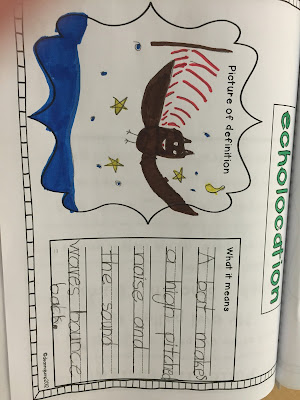Last week, we read Stellaluna. We created a story map to check for understanding...then we made a Venn diagram on the SMARTboard to compare bats and birds. How are they the same? How are they different? After, we discussed if we rather be a bat or a bird.
In Stellaluna, we learned that mother bats find their pups by smelling their fur. We did an experiment to see how this worked. Each student was blindfolded and given a scent (pup) to smell. They had to remember the scent (pup) they had. After everyone had their scent (pup) memorized we mixed all the scents (pups) together. Students had to use their sense of smell to find their "pup." We also learned the life cycle of a bat!
Then, we learned about hibernation and migration. We learned that bats hibernate and migrate depending on where they live. We played, "Who woke the sleepy bat." One student was chosen to sit in the middle of the class and they had to pretend they were sleeping like a bat. Another student was picked and they had to sneak up on the bat and touch them without waking them. Then everyone in the class said "Wake up sleepy bat! Wake up!" The student who was chosen to be the bat then woke up. Then they had to try and guess who woke them up.
We learned that bats are equipped in remarkable ways to hunt at night. They use sound waves and a technique called echolocation. We did a few experiments to test how echolocation works. First, we explored how sound vibrations work through using a rubber band. Second, I played music at a low volume and everyone cupped their hands over their ears. We noticed that the music seemed louder when we cupped our ears. This is because sound travels through the air in waves, which spread out in all directions. When we listened to the music the first time, a few sound waves reached our ears, but when our ears were cupped, more sound waves were captured and channeled. Bats ears are large and cupped, therefore much more efficient than human ears. They can capture a tiny mosquito in complete darkness just by using their sense of sound!
This week we learned about owls! We learned that owls are birds of prey. That means that they hunt the animals that they eat. After an owl eats small rodents, & birds its stomach cannot digest the fur, bones, teeth & feathers. These extra parts are formed into a tight pellet inside the owl. Later, these parts are spit up! We were lucky enough to have the opportunity to dissect owl pellets. It was pretty neat! Each student was given a pellet, tweezers, a bone chart & a magnifying glass. We found mouse bones, skulls and feathers!
After, we learned the parts of an owl, the life cycle of an owl and we learned about different types of owls.
In Stellaluna, we learned that mother bats find their pups by smelling their fur. We did an experiment to see how this worked. Each student was blindfolded and given a scent (pup) to smell. They had to remember the scent (pup) they had. After everyone had their scent (pup) memorized we mixed all the scents (pups) together. Students had to use their sense of smell to find their "pup." We also learned the life cycle of a bat!
Then, we learned about hibernation and migration. We learned that bats hibernate and migrate depending on where they live. We played, "Who woke the sleepy bat." One student was chosen to sit in the middle of the class and they had to pretend they were sleeping like a bat. Another student was picked and they had to sneak up on the bat and touch them without waking them. Then everyone in the class said "Wake up sleepy bat! Wake up!" The student who was chosen to be the bat then woke up. Then they had to try and guess who woke them up.
We learned that bats are equipped in remarkable ways to hunt at night. They use sound waves and a technique called echolocation. We did a few experiments to test how echolocation works. First, we explored how sound vibrations work through using a rubber band. Second, I played music at a low volume and everyone cupped their hands over their ears. We noticed that the music seemed louder when we cupped our ears. This is because sound travels through the air in waves, which spread out in all directions. When we listened to the music the first time, a few sound waves reached our ears, but when our ears were cupped, more sound waves were captured and channeled. Bats ears are large and cupped, therefore much more efficient than human ears. They can capture a tiny mosquito in complete darkness just by using their sense of sound!
This week we learned about owls! We learned that owls are birds of prey. That means that they hunt the animals that they eat. After an owl eats small rodents, & birds its stomach cannot digest the fur, bones, teeth & feathers. These extra parts are formed into a tight pellet inside the owl. Later, these parts are spit up! We were lucky enough to have the opportunity to dissect owl pellets. It was pretty neat! Each student was given a pellet, tweezers, a bone chart & a magnifying glass. We found mouse bones, skulls and feathers!
After, we learned the parts of an owl, the life cycle of an owl and we learned about different types of owls.
If you are interested in purchasing any of these handouts you can purchase them on Teachers Pay Teachers.





































No comments :
Post a Comment